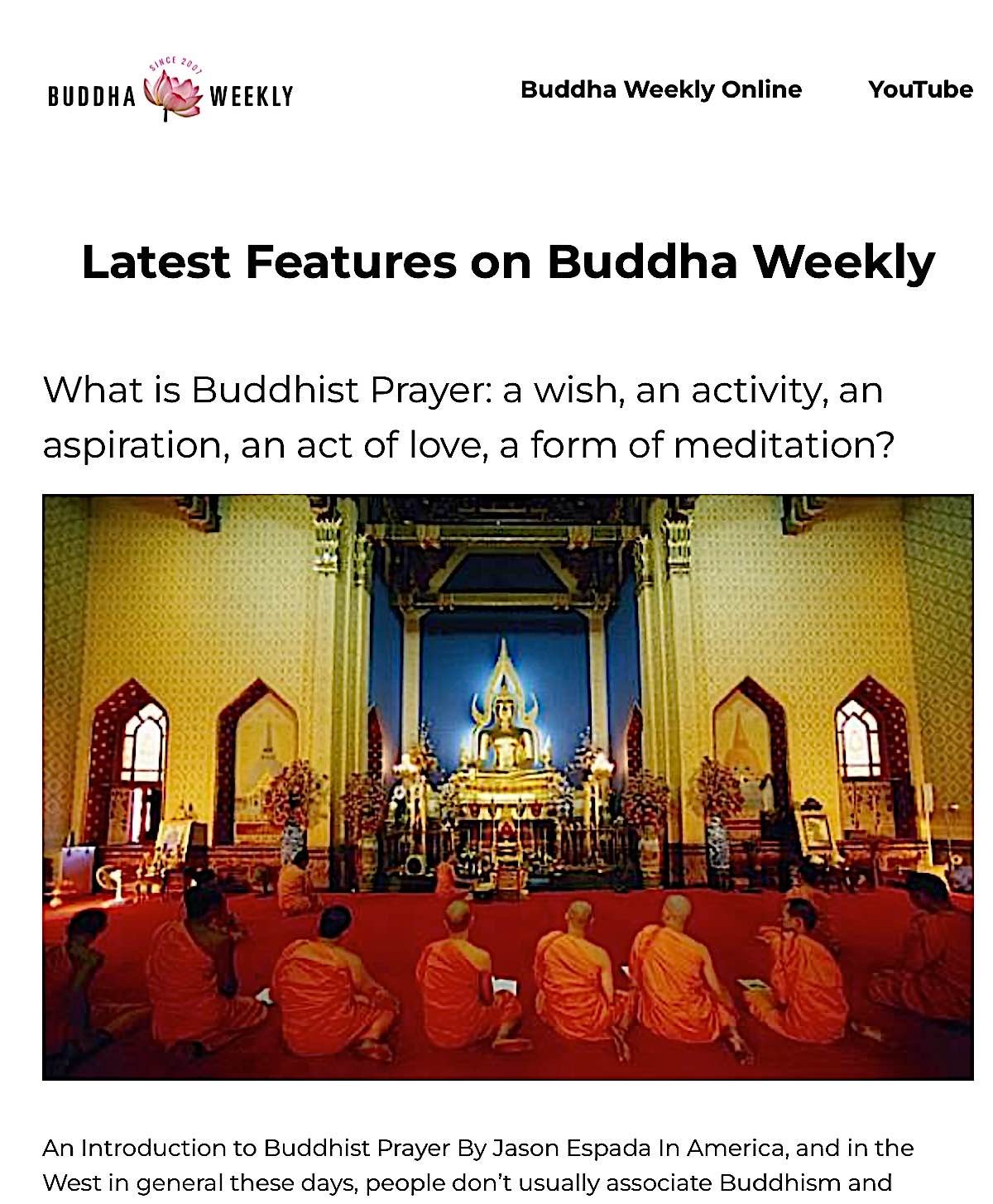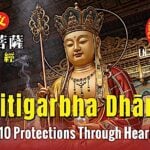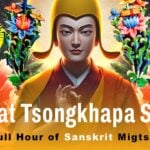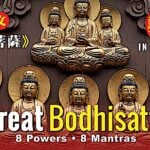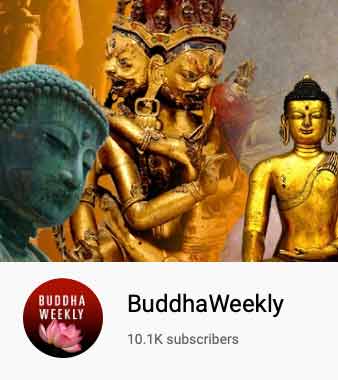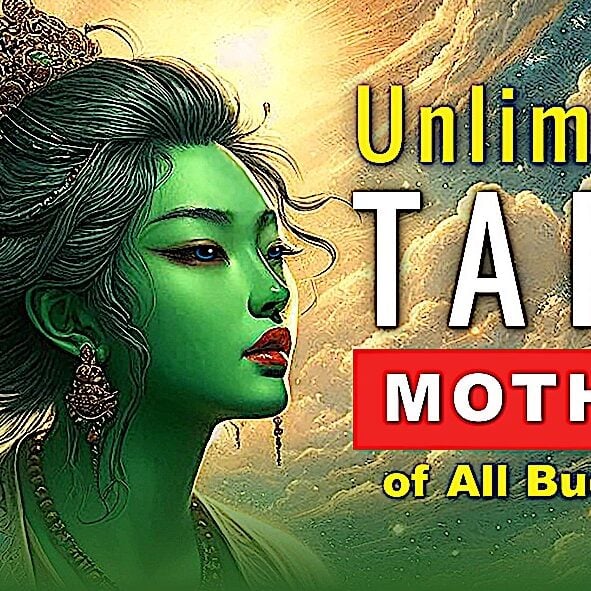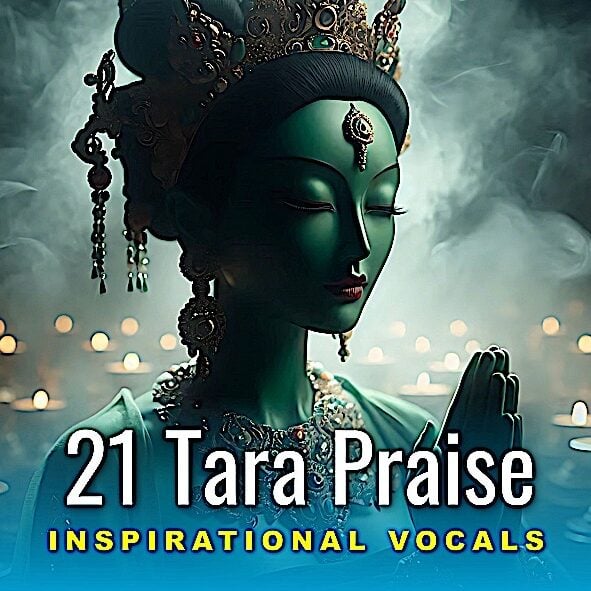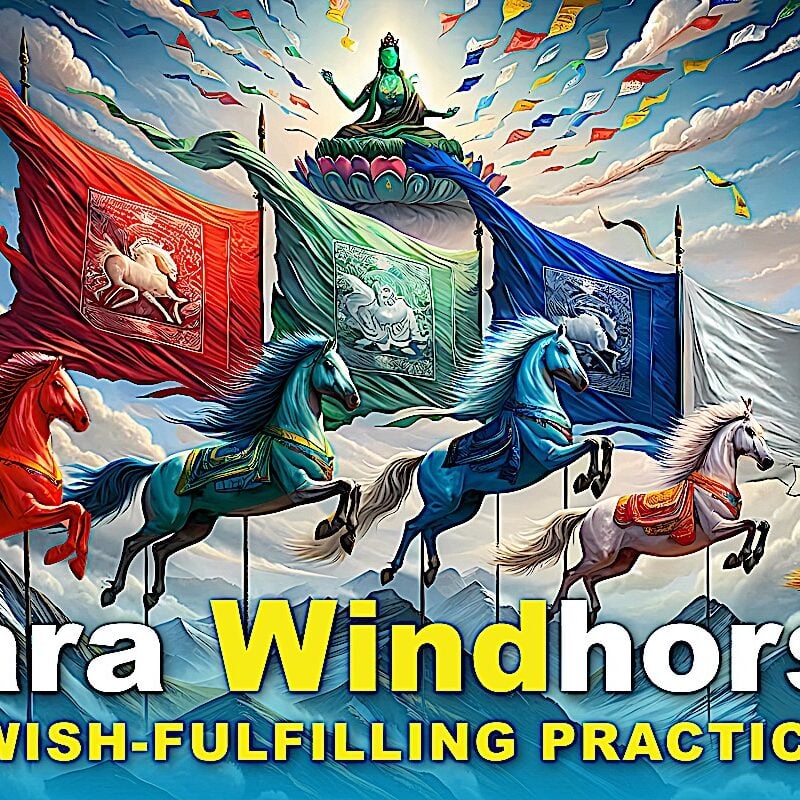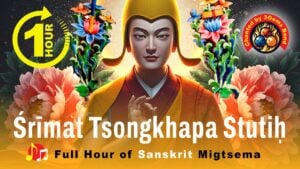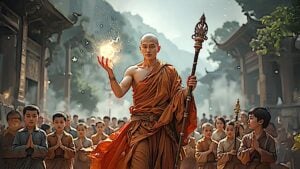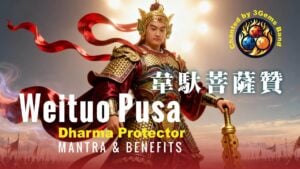Windhorse Tara Practice: Tara, the Wind of Life; Tara, Goddess of Wind, Buddha of Activity, Karma Mother
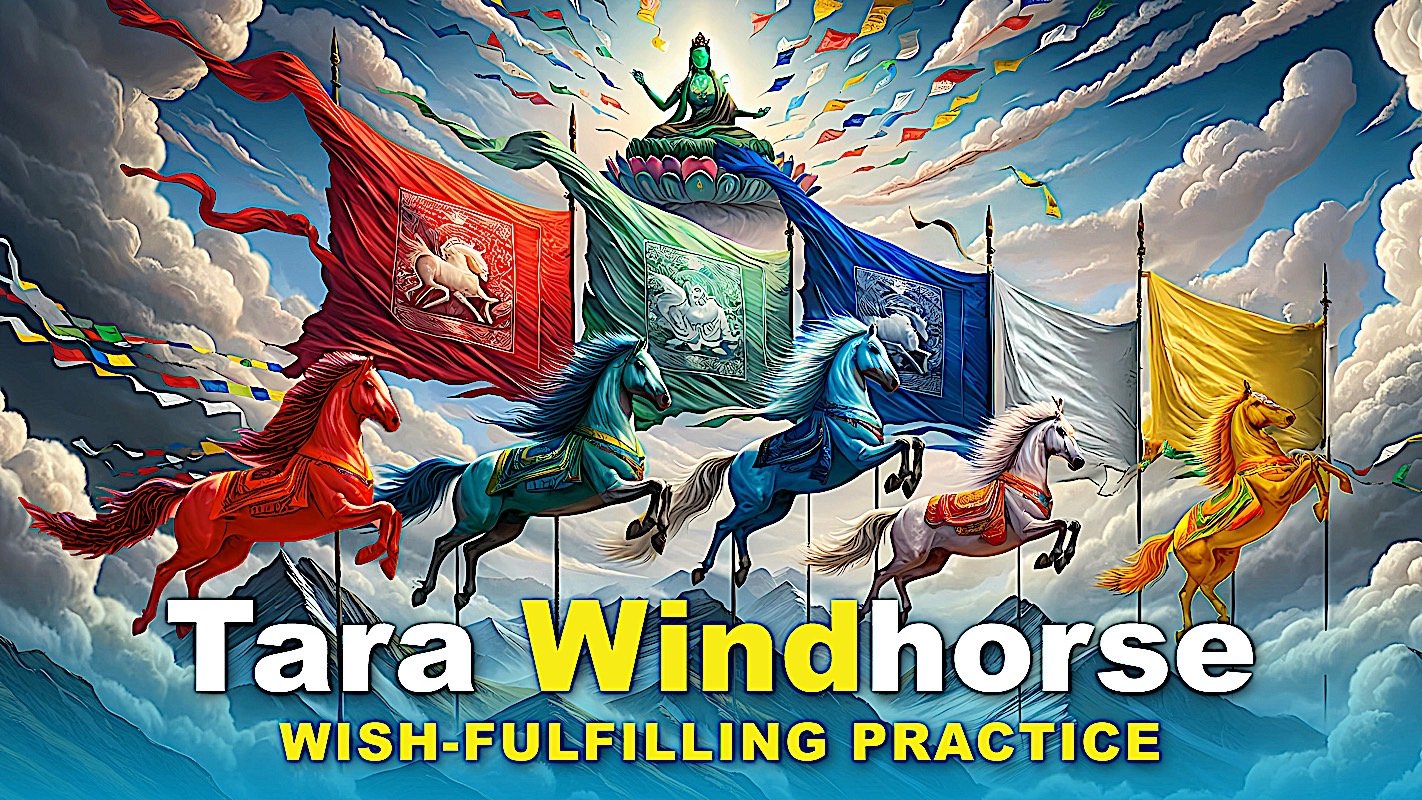
Why is the special wish-fulfilling practice of Windhorse Tara so treasured among Tara practitioners in Tibetan Buddhism? Why is it so well-known for helping us fulfill our wishes and overcome our obstacles. Why are all Taras associated with Chi, Prana and life’s breath? Why is Air and wind and Buddha Mother Tara associated with Karma Activity? And, why is Karma Activity the most important of Buddhist practices?
Video:
- PDF of this Tara Windhorse Wish-Fulfilling Practice Recitation available for download here>>
Tara Windhorse Practice is one of the most popular practices in Vajrayana and Mahayana. Windhorse refers to Prana, or Chi, which is Buddha Mother Tara’s domain. It also refers to fulfilling wishes, since we see the Windhorse on every prayer flag in Tibetan tradition. The Windhorse symbolically carries our wishes, prayers and aspirations on Tara’s winds, so that she hears our noble aspirations. You also see windhorse flags of different colors, representing different activities.
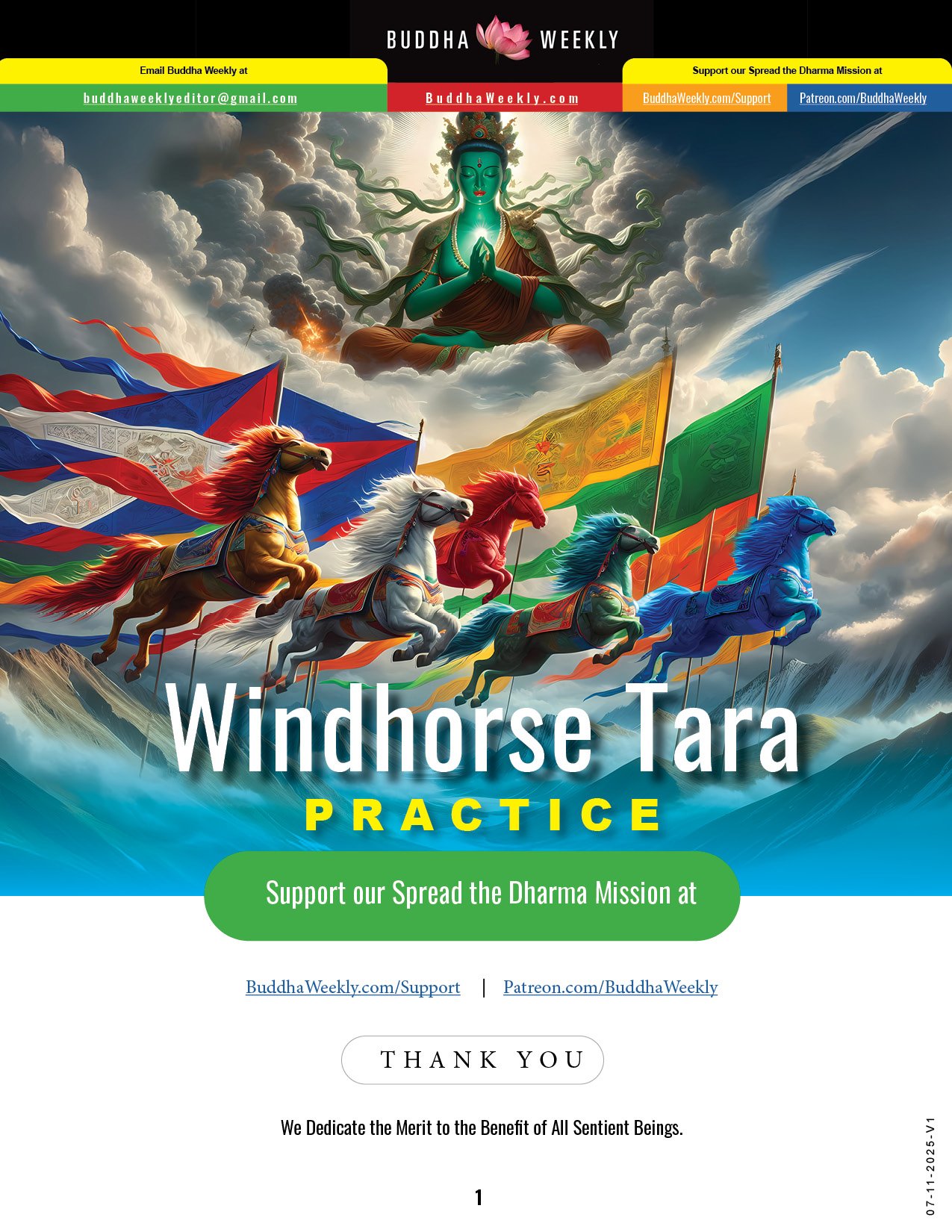
In this practice, we begin by Taking Refuge, followed by the 21 Tara’s Dharani praise as many times as you can, then end with this visualization and practice — which sends your aspirations and wishes to Green, White, Red, Yellow, Blue or Black Tara, ensuring speed wish-fulfilment and blessings.
How does this work?
Consider that the foundation of life is air. The foundation of sound is also air. Without air, there is no sound. Without sound there is no Enlightened Speech or Dharma or mantra. In other words, it is Tara’s wind which empowers every mantra.
SONG VERSION OF THIS PRAISE BY THE @3GemsBand – 3Gems Band is a Buddha Weekly volunteer group writing original music and performing with beautiful vocals.
One of her wrathful forms, Ekajati, is the goddess of secret mantra for this reason. Sound is also extensively used in practice in the forms of drums, wind instruments and bells. It is the bell that represents wisdom and Mother Tara in practice. Singing bowl practice is also a healing modality. Sound, in Buddhism, is the most important of methods.
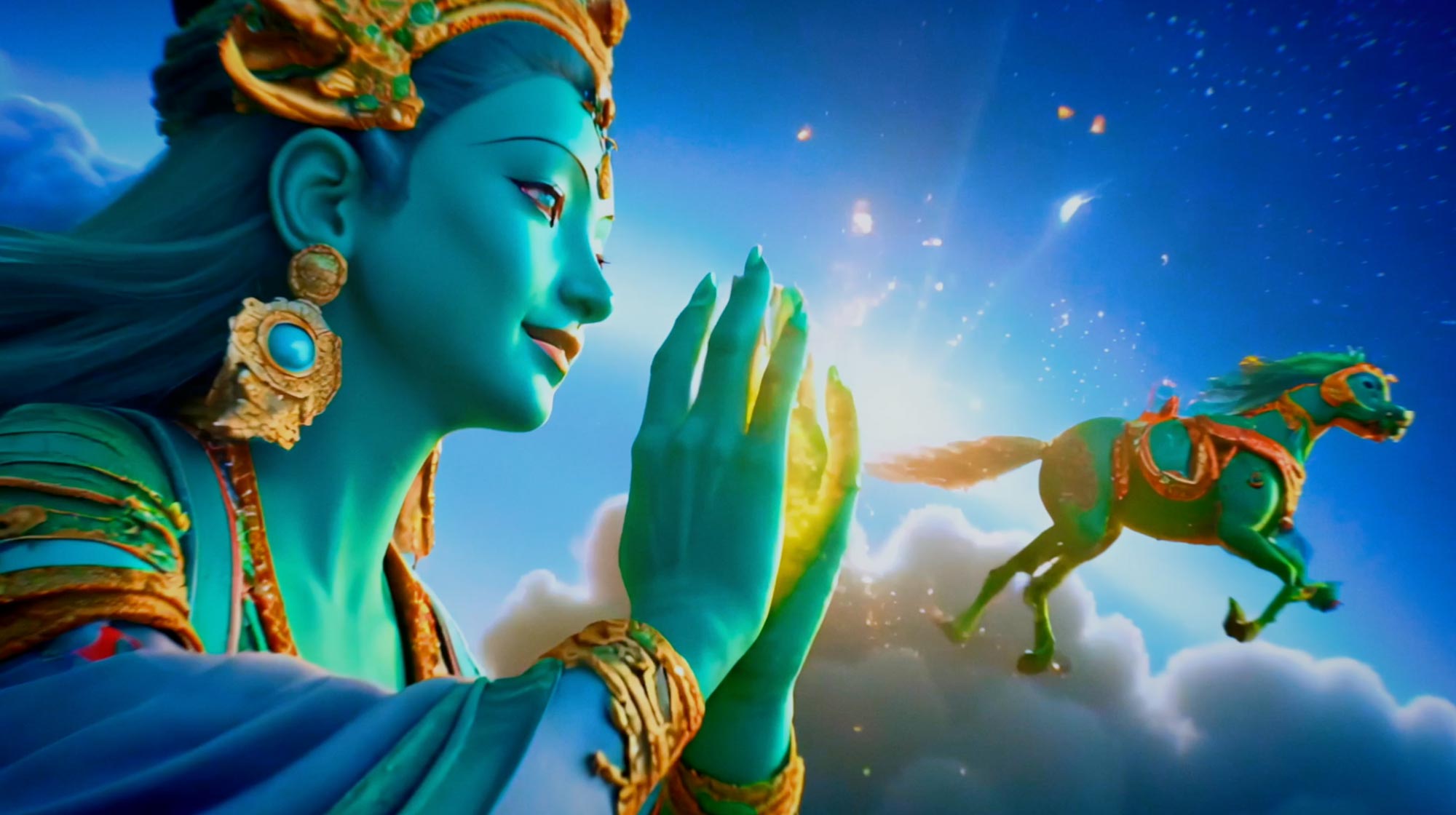
Due to the importance of wind and sound in Buddhism, and also life-sustaining chi, the Windhorse Tahra practice is very important. It is a potent way to tap into her power and blessings. It is both supplication for blessings, and praise of her qualities as the Activity of all the Buddhas. Usually we recite it at the end of a 21 Tahra Praise Dharani, or any Tahra practice. Likewise, we end this presentation with an English recitation of this wonderful daily practice.
In Buddhism, one of the first meditations taught is to simply meditate with the breath. This is, in essence, a Tara practice, since Tara is the wind or activity of all the Buddhas. Mother Tara, the Karma Mother is the Air Element Buddha, the most important of the elements. She carries your wishes on her winds.
The Breath of Life. The Prana which moves through all things. Windhorse is the affectionate name for Prana or Qi, or the Wind of Life. Qi or Prana flows through all life, not only humans, but the Cosmos itself. Mother Earth herself, is sustained by Qi or Prana or Windhorse.
In Feng Shui, entire building designs are often changed due to the flow of land Qi. One of the most important of Vajrayana practices for senior students and practitioners is working with the internal body channels, wind or prana, and essence drops.
All of these are synonomous with Mother Tara, the Karma Buddha of Air, Qi, Prana and Wind. The famous Windhorse Practice of Tara is a praise usually performed at the end of the 21 Tara’s practice, or the end of any Tara practice. The Windhorse practice supplicates Tara, after the 21 Praises, to help you with your noble wishes. In advanced practices, the Highest Yogas, we also have Tara’s body mandala practices, one of the most beautiful of meditations.
It is because of Qi, or the breath of life, or Prana, that Mother Tara takes on such importance and devotion. She is associated with activity, and with healing, and with life itself. She is also known as the heroic goddess, because she is the embodiment of Qi or Prana and activity and karma. She is the Wind Horse Mother. The 21 Activities expressed in her sacred Dharani, translated as the Praise of the 21 Taras, expresses this activity of wind or breath or prana of the Universe.
Many practitioners also think of Tara as Mother Earth. She is Green, like the earth. She is Tara of the Khadira Fragrant Forest. Yet this is her aspect as the Windhorse or Qi or Mother Earth. Her manifestations as Golden or Yellow Taras, such as Vasudhara, are the essence of Earth Mother herself.
Another of her important prana related practices are her body mandala practice, where we visualize Tara’s of different forms on each of our Chakras in our inner body. This is Tara of the human body, the inner chi and winds of our body.
We are a mirror, a microcosm of the universe, the macrocosm. Our chi is part of the universe Chi. Our chi connects us directly to Mother Tara, the Mother of Wind and Prana.
What is the relationship between Green mother Earth and the Wind element? Wind and air is the very foundation of life. Gelek Rimpoche taught in teachings on Mother Tara:
“The strongest element on which we base life is air, not ground, not earth. That is because air is the basis of the nature of sound. Really, it is. That is why air is the strongest out of four elements, which are earth, water, fire, and air. Air is the very base.”
In Buddhism, Wind symbolizes karma or activity. Tara is the mother of the Karma family of the North and the element of air or wind. This is why Tara’s body mandala practices, found in the Highest Yoga forms, are the most treasured. When we work with the body mandalas, we enhance and strengthen our inner body, in a way similar to Qigong or Tai Chi or Tibetan Yantra Yoga.
In Dharmic philosophy we speak of Prana or Qi or wind or lung. How important is Lung or Prana? In Tibetan Buddhism, mantra transmissions are called རླུང. Of all the empowerments, lung transmission is the most important, due to the nature of sound. The empowerment super charges sound, blessing it as the Enlightened speech. It also fortifies, in a healthy way, our inner body Prana, chi or རླུང.
Aside from stilling the mind, the yogas or meditaiton on breath are training for Enlightened Speech, or mantra. Breath training also fortifies our body, our health, by bringing in healthy prana and expelling negative wind.
This is a universal concept. It is not only the breath of our life, the air in our lungs; it is equally the prana or chi of our internal body that sustains us, gives us energy and life. And, connecting us all, this chi or prana is the essence of all life, not only humans. And the earth and cosmos itself. Everything is “alive” and thriving due to Prana or Qi or air.
In martial arts film we’ll see incredible acts of kung fu that would normally seem impossible. This is the power of Qi or Prana or རླུང.
Prana, or Qi, windhorse, or རླུང are embodied in Tara, the Windhorse Mother.
The importance of Qi and wind is reinforced by one of the best known metaphors for Buddhist practice, the two wings of the bird. In this metaphor, one wing is wisdom, the is compassion. Unless both wings flap, the bird cannot fly. In other words, metaphorical flight to Enlightenment is only possible with both. But there is a third requirement, which is Tara’s domain. The wings must move. Without activity, there can be no flight. And the bird flies on the element of wind or air — there can be no flight without it. Likewise, without Tara’s karma activity, wisdom and compassion are just mental philosophies. They have to be put into action.
Wisdom is only a concept, unless we meditate. Compassion is only a concept unless we engage in compassionate activity. This is why we see Tara in every color, in every Buddha Family. We have White Tara and Green Tara and Red Tara and Blue Tara and Black Tara and Yellow Tara. We have 21 Taras who specialize in 21 activities. We have 108 Taras, and 1008 Taras.
All of these Tara’s show us that wisdom and compassion are only philosophical — unless we also practice what is written. Practice is the domain of Mother Tara, including something as simple as “breath” meditation.
We create good karma through positive activities, wise activities and compassionate activities. This is Tara activity. This is why Tara is perpetually popular, in Mahayana Buddhism, where the Bodhisattva mission of helping all sentient beings is vital. She is the Mother of all Wisdom and Compassion activities which help all beings. Her practices are all active, embodying all of the aspects of Enlightened Body, Speech and Mind.
To give a simple practice example. A Sutra text contains Wisdom. A Buddhist reads or copies a sutra with the intention of benefiting other beings, which is compassion. The act of reading, and especially of reading it to others, is Karma activity, or Mother Tara’s activity.
To support our practice, we visualize Tara in front of us to represent Enlightened Body. We chant her mantras and praises to respresent her Holy speech. And, we meditate on her nature to represent Her Mind.
Especially because Tara is the activity, or Karma mother, teachers consistently caution us not to visualize Tara — or indeed any Buddha, but most especially Tara — as static images, like a statue or a thangka painting. This is why, for example, in our 21 Tara videos, we try to visualize actions, animating activity, rather than showing static museum artwork.
Even in static artwork, we see Tara’s foot thrust out towards us, ready to leap to her feet. This is to symbolically represent her activity.
Venerable Thubten Jigme of Sravasti Abbey, in a teaching said on Tara explained:
“When we imagine Green Tara, we’re not imagining a two Dimensional picture or a statue, but a live, three dimensional figure made of light.”
Especially for Tara visualizations, we should see her as alive with activity and energy. Even for Manjushri, or Shakyamuni, we might imagine them teaching. The important thing is not to lock into the idea of a snapshot.
Tara practice is found in all areas of practice. She manifests in all five Buddha Families as Green, Blue or Black, Yellow or Gold, Red and White. She is part of important foundation practices, Kriya Yogas, activity Yogas, and even Highest Yoga Tantras, Anutara Yogas. There are also Completion and Body Yoga practices, as you’d expect for the Goddess of Winds and Prana.
In their brilliant book, Skillful Grace, Tara Practice for our Times, a classic in Tara literature, Tulku Urgyen Rinpoche and Adeu Rinpoche wrote:
“Buddha Shakyamuni himself, when teaching a sutra and a tantra on Tara, said that among all the other buddhas, Manjushri and Tara are the two who have exceedingly great resolve. Tara is like an emanation of the mother of all the buddhas of the three times. She carries out all their activities, dispelling the obstacles created through the eight or sixteen types of fear.”
One of the most treasured practices in Buddhism is the 21 Tara’s practice. Each of the 21 Taras and their praises illuminates a different Tara Activity. The praise itself mentions that you should begin with 21 Tara Praise, and end with your Windhorse meditation. You can add this to any of your Tara practices, since every Tara is of the Wind element.
At the end of the 21 Taras chanting, or at the end of your Tara practice, there is a well-known practice from the great teacher Trulshik Adeu Rinpoche, called Windhorse Practice of Tara. According to the introductory praise, This windhorse practice relying upon Noble Lady Tārā is a prayer that fulfils all wishes.
At the end of the Tārā practice, or after reciting the Praises to Tārā as much as one can.
Visualize the wish-fulfilling horse carrying your wishes into the sky to Tara’s ear. The wish-fulfilling horse is a beautiful flying horse, with the symbol of the Three Jewels, or the wish-fulfilling jewel on his back. He carries your wishes to Tara.
For this practice, we visualize a white windhorse for our noble wisdom and pacifying aspirations, carrying our wishes skyward to Tara. If we are able to visualize in detail, after the introductory praise, we visualize a white windhorse carrying our pacifying wishes and supplications to White Tara. This is followed by a Golden windhorse carrying our enriching and growth wishes to Golden Yellow Tara. Then, a red windhorse carrying our controlling and magnetizing wishes to Red Tara. Next, is a blue windhorse carrying our wishes to “repel our enemies”, who include both internal and external enemies. Finally, a green windhorse carriers our final wishes for protection and refuge to Green Tara. Or, if this is too difficult, you can see the more traditional white Windhorse riding skyward on a rainbow of the same five colors. If this is too difficult, you see just the rainbow of light leaving your body and entering Tara’s body of light.
As you meditate and chant the verses, mentally recall your specific wishes.
Trulshik Adeu Rinpoche explains the benefits in the two lines before we begin:
This windhorse practice, relying upon Noble Lady Tārā, is a prayer that fulfils all wishes.
At the end of the Tārā practice, or after reciting the Praises to Tārā as much as one can, begin:
Oṃ. Queen of space, savior of all beings,
Perfectly pure essence of wind that pervades all,
You give birth to all worlds and cause them to flourish.
Noble Lady Tārā, I pay homage to you!
Lady whose face gleams as white as the autumn moon,
By pacifying all adversity and affliction,
And spontaneously bringing favorable conditions and fulfiling wishes,
Generate the windhorse of dissolving the eight dangers into space!
Lady who shines as brightly as the golden sun,
By eliminating all decadence and poverty,
And increasing lifespan, merit, wealth and renown,
Generate the windhorse of expanding prosperity and fortune!
Lady who blazes with the luster of red rubies,
By dispelling all dependency and misfortune,
And bringing the whole apparent world under my control,
Generate the windhorse of magnetizing the triple world!
Lady who sparkles with blue sapphire brilliance,
By repelling all enemies, obstacles and harm,
And granting total victory over all danger and adversity,
Generate the windhorse of overpowering demonic hordes!
Lady who beams with emerald green light,
By pacifying all unwanted circumstances,
And accomplishing all aims with auspicious glory,
Generate the windhorse of acting on a space-like scale!
Ye dharmā hetuprabhavā hetuṃ teṣāṃ tathāgataḥ hyavadat teṣāṃ ca yo nirodha evaṃ vādī mahāśramaṇaḥ svāhā
ये धर्मा हेतु प्रभवा हेतुं तेषां तथागतः ह्यवदत् तेषां च यो निरोध एवं वादी महाश्रमणः svāhā
The one who holds the name of the Eighth Trulshik composed this to fulfill the earnest request of Golok Akyong Miwang Tendzin Gyatso, and due to the dire need for such a prayer. May it be the cause of total victory!
Adding this earnest request to your 21 Tara’s practice will ensure your wishes and aspirations are carried on the winhorse to blessed Mother Tara.
We dedicate the merit of this practice to the benefit of all sentient beings.
༄༅། །སྒྲོལ་མའི་ཀླུང་རྟ།
Windhorse Practice of Tārā
by Trulshik Adeu Rinpoche
རྗེ་བཙུན་འཕགས་མ་སྒྲོལ་མ་ལ་བརྟེན་ནས་རླུང་རྟ་བསྐྱེད་པའི་འདོད་དོན་གསོལ་འདེབས་ནི།
This windhorse practice relying upon Noble Lady Tārā is a prayer that fulfils all wishes.
སྒྲོལ་ཆོག་གི་མཇུག་ཐོག་གམ། སྒྲོལ་བསྟོད་གང་མང་རྗེས།
At the end of the Tārā practice, or after reciting the Praises to Tārā as much as one can, begin:
ཨོཾ། ནམ་མཁའི་རྒྱལ་མོ་འགྲོ་བ་ཀུན་སྒྲོལ་མ། །
om, namkhé gyalmo drowa kün drolma
Oṃ. Queen of space, savior of all beings,
ཀུན་ཏུ་ཁྱབ་པ་རྣམ་དག་ཀླུང་གི་ཁམས། །
küntu khyabpa namdak lung gi kham
Perfectly pure essence of wind that pervades all,
འཇིག་རྟེན་ཁམས་ཀུན་བསྐྱེད་དང་འཕེལ་བྱེད་པའི། །
jikten kham kün kyé dang pel jepé
You give birth to all worlds and cause them to flourish.
འཕགས་མ་སྒྲོལ་མའི་ཞབས་ལ་ཕྱག་འཚལ་ལོ། །
pakma drolmé zhab la chaktsal lo
Noble Lady Tārā, I pay homage to you!
དཀར་མོ་སྟོན་ཟླ་རྒྱས་པའི་ཞལ་མངའ་མ། །
karmo tön da gyepé zhal nga ma
Lady whose face gleams as white as the autumn moon,
གང་དེས་མི་མཐུན་གནོད་པ་ཀུན་ཞི་ཞིང་། །
gang dé mitün nöpa kün zhi zhing
By pacifying all adversity and affliction,
མཐུན་རྐྱེན་བསམ་དོན་ལྷུན་གྱིས་འགྲུབ་མཛད་པས། །
tünkyen samdön lhün gyi drub dzepé
And spontaneously bringing favorable conditions and fulfiling wishes,
འཇིགས་བརྒྱད་དབྱིངས་སུ་ཞི་བའི་ཀླུང་རྟ་བསྐྱེད། །
jikgyé ying su zhiwé lung ta kyé
Generate the windhorse of dissolving the eight dangers into space!
སེར་མོ་གསེར་མདོག་ཉི་མའི་གཟི་མངའ་མ། །
sermo ser dok nyimé zi nga ma
Lady who shines as brightly as the golden sun,
གང་དེས་རྒུད་དང་ཕོངས་པ་ཀུན་སེལ་ཞིང་། །
gang dé gü dang pongpa kün sel zhing
By eliminating all decadence and poverty,
ཚེ་བསོད་དཔལ་འབྱོར་གྲགས་པ་རབ་འཕེལ་བས། །
tsé sö paljor drakpa rab pelwé
And increasing lifespan, merit, wealth and renown,
ཕུན་ཚོགས་དཔལ་ཡོན་རྒྱས་པའི་ཀླུང་རྟ་བསྐྱེད། །
püntsok palyön gyepé lung ta kyé
Generate the windhorse of expanding prosperity and fortune!
དམར་མོ་རཱ་གའི་མདངས་ལྡན་གཟི་འབར་མ། །
marmo ragé dangden zibar ma
Lady who blazes with the luster of red rubies,
གང་དེས་གཞན་དབང་འགལ་རྐྱེན་ཀུན་སེལ་ཞིང་། །
gang dé zhenwang galkyen kün sel zhing
By dispelling all dependency and misfortune,
རང་དབང་འཇིག་རྟེན་སྣང་བ་ཀུན་འདུ་བས། །
rangwang jikten nangwa kün duwé
And bringing the whole apparent world under my control,
ཁམས་གསུམ་དབང་དུ་འདུ་བའི་ཀླུང་རྟ་བསྐྱེད། །
kham sum wang du duwé lung ta kyé
Generate the windhorse of magnetizing the triple world!
སྔོན་མོ་ཨིཎྜ་ནི་ལའི་མདངས་ལྡན་མ། །
ngönmo indanilé dangden ma
Lady who sparkles with blue sapphire brilliance,
གང་དེས་དགྲ་གདོན་གནོད་པ་ཀུན་བཟློག་ཅིང་། །
gang dé dra dön nöpa kün dok ching
By repelling all enemies, obstacles and harm,
མི་མཐུན་འཇིགས་པའི་ཕྱོགས་ལས་རྣམ་རྒྱལ་བས། །
mitün jikpé chok lé namgyalwé
And granting total victory over all danger and adversity,
བདུད་སྡེ་ཟིལ་གྱིས་གནོན་པའི་ཀླུང་རྟ་བསྐྱེད། །
dü dé zil gyi nönpé lung ta kyé
Generate the windhorse of overpowering demonic hordes!
ལྗང་མོ་མ་ར་ཀ་ཏའི་འོད་ལྡན་མ། །
jangmo ma ra katé öden ma
Lady who beams with emerald green light,
གང་དེས་མི་འདོད་ཕྱོགས་རྣམས་ཀུན་ཞི་ཞིང་། །
gang dé mindö chok nam kün zhi zhing
By pacifying all unwanted circumstances,
བཀྲ་ཤིས་དཔལ་གྱིས་དོན་ཀུན་འགྲུབ་བྱེད་པས། །
tashi pal gyi dön kün drub jepé
And accomplishing all aims with auspicious glory,
ཕྲིན་ལས་མཁའ་དང་མཉམ་པའི་ཀླུང་རྟ་བསྐྱེད། །
trinlé kha dang nyampé lung ta kyé
Generate the windhorse of acting on a space-like scale!
རྟེན་འབྲེལ་སྙིང་པོ་བརྗོད།
Next, recite the Essence of Interdependence mantra (Tendrel Nyingpo):
ཨོཾ་ཡེ་དྷརྨཱ་ཧེ་ཏུ་པྲ་བྷཱ་ཝཱ་ཧེ་ཏུནྟེ་ཥཱནྟ་ཐཱ་ག་ཏོ་ཧྱ་ཝ་དཏ། ཏེ་ཥཱཉྩ་ཡོ་ནི་རོ་དྷ་ཨེ་ཝྃ་ཝཱ་དཱི་མ་ཧཱ་ཤྲ་མ་ཎཿསྭཱ་ཧཱ།
om yé dharma hetu prabhava hetun teshan tatagato hyavadat | teshan tsa yo nirodha evam vadi maha shramana soha
oṃ ye dharmā hetu prabhāvā hetuṃ teṣāṃ tathāgato hyavadat | teṣāṃ ca yo nirodha evaṃ vādī mahāśramaṇaḥ svāhā ||
ཅེས་པའང་མགོ་ལོག་ཨ་སྐྱོང་མི་དབང་བསྟན་འཛིན་རྒྱ་མཚོས་ནན་ཆེར་བསྐུལ་མ་གནང་བའི་བཞེད་སྐོང་དང་། སྐབས་སུ་བབས་པའི་དགོས་དབང་ཁྱད་པར་ཅན་བྱུང་བར་རྟེན། འཁྲུལ་ཞིག་བརྒྱད་མིང་པས་བྲིས་པ་ཕྱོགས་ལས་རྣམ་པར་རྒྱལ་བའི་རྒྱུར་གྱུར་ཅིག །
The one who holds the name of the Eighth Trulshik composed this to fulfill the earnest request of Golok Akyong Miwang Tendzin Gyatso, and due to the dire need for such a prayer. May it be the cause of total victory!
SOURCE for text of Windhorse Practice of Tara
| Samye Translations (trans. Peter Woods and Stefan Mang) with the kind assistance of Adam Pearcey, 2020.
Lotsawa House
https://www.lotsawahouse.org/tibetan-masters/adeu-rinpoche/tara-windhorse
Samye Translations:
More articles by this author
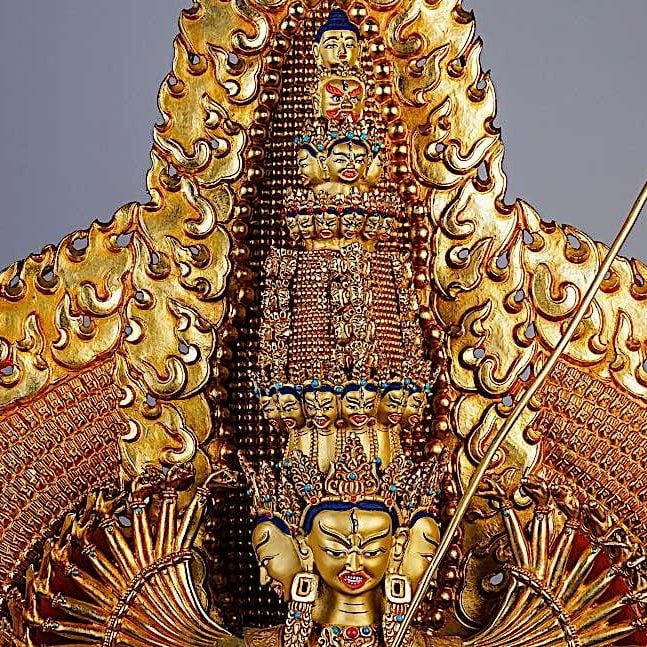
Sitatapatra or Dukkar — the ultimate protective Bodhisattva Goddess, form of Mother Tara — 1000 arms or 2 arms, she is “Aparajita” the Undefeatable One
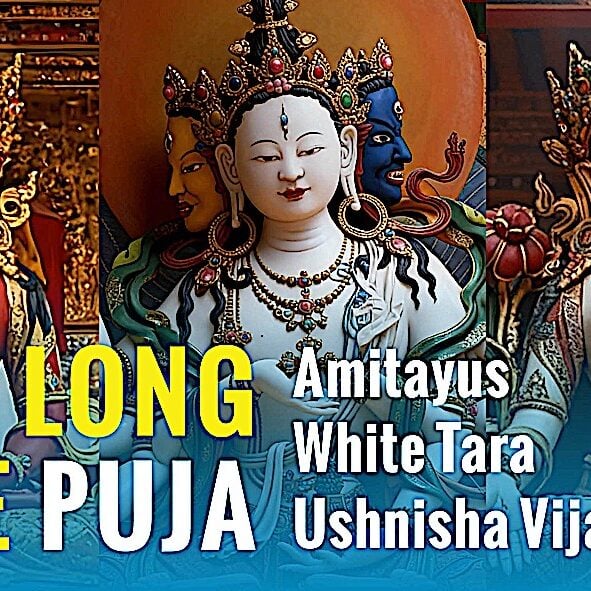
✨ Official Music Video: 3 DEITIES LONG LIFE PUJA AND MANTRAS : Benefits long life, healing, purification, auspiciousness PERFORMED BY @3GemsBand for Supreme Merit Day! ✨
Search
Latest Features
Please support the "Spread the Dharma" mission as one of our heroic Dharma Supporting Members, or with a one-time donation.
Please Help Support the “Spread the Dharma” Mission!
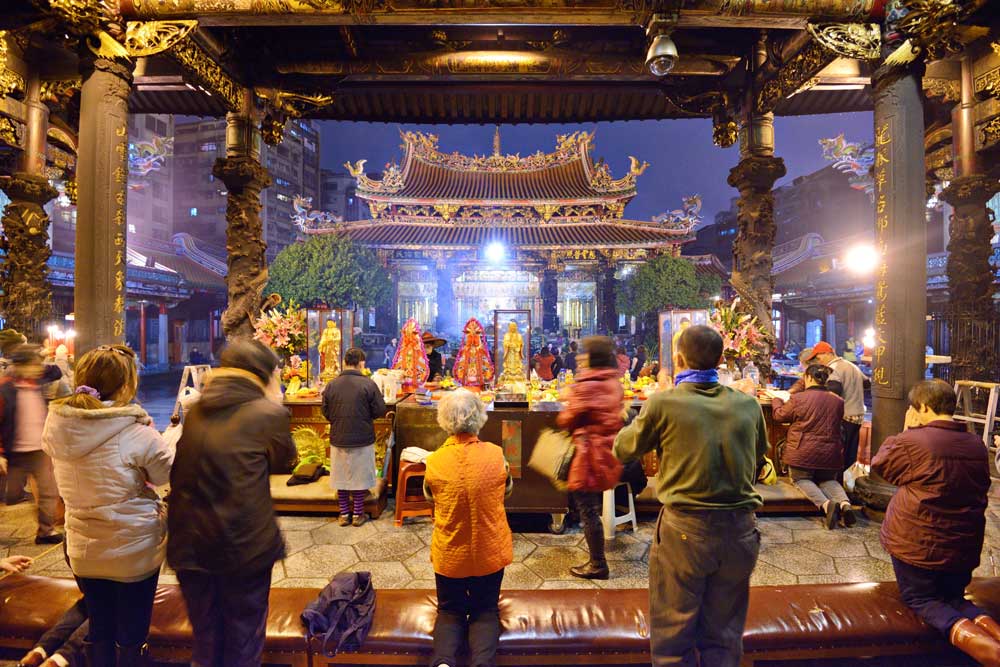
Be a part of the noble mission as a supporting member or a patron, or a volunteer contributor of content.
The power of Dharma to help sentient beings, in part, lies in ensuring access to Buddha’s precious Dharma — the mission of Buddha Weekly. We can’t do it without you!
A non-profit association since 2007, Buddha Weekly published many feature articles, videos, and, podcasts. Please consider supporting the mission to preserve and “Spread the Dharma." Your support as either a patron or a supporting member helps defray the high costs of producing quality Dharma content. Thank you! Learn more here, or become one of our super karma heroes on Patreon.
Lee Kane
Author | Buddha Weekly
Lee Kane is the editor of Buddha Weekly, since 2007. His main focuses as a writer are mindfulness techniques, meditation, Dharma and Sutra commentaries, Buddhist practices, international perspectives and traditions, Vajrayana, Mahayana, Zen. He also covers various events.
Lee also contributes as a writer to various other online magazines and blogs.

